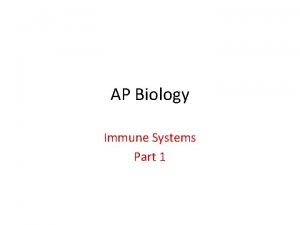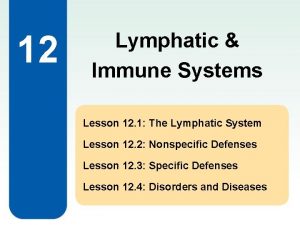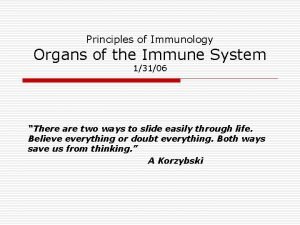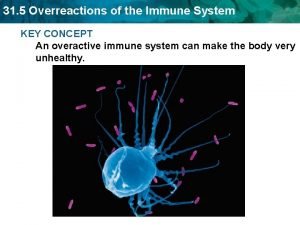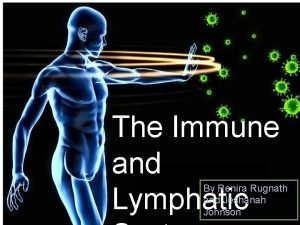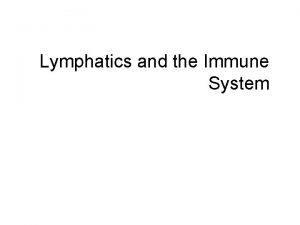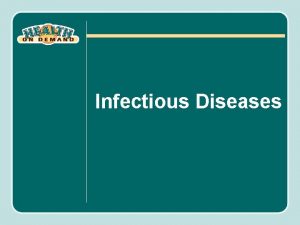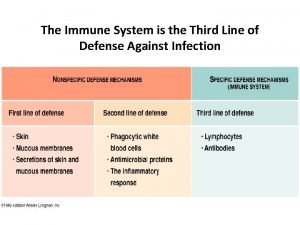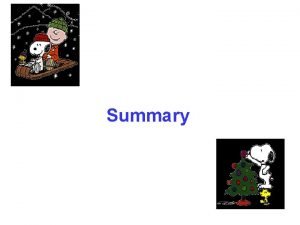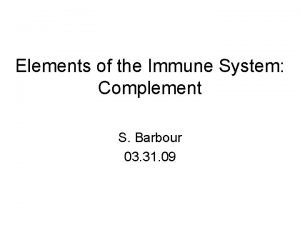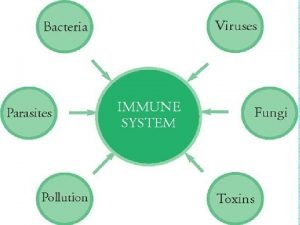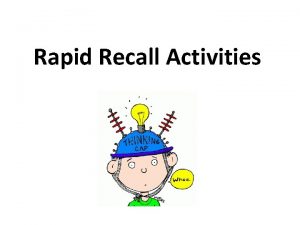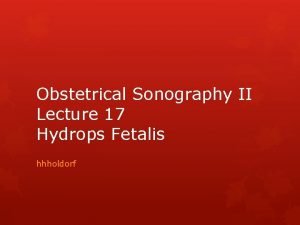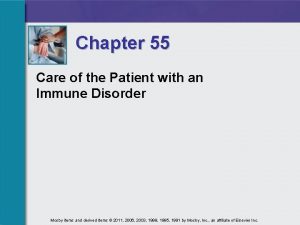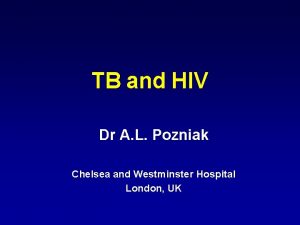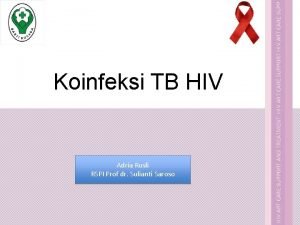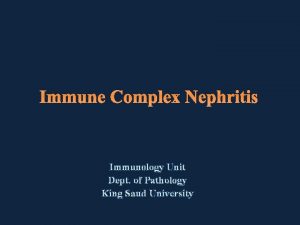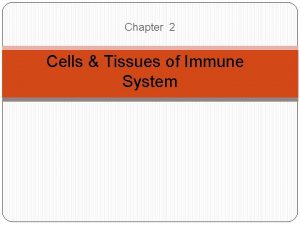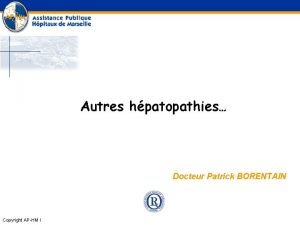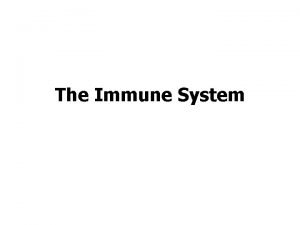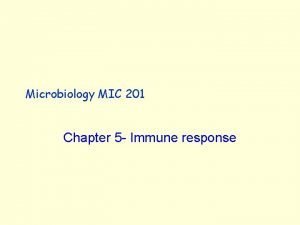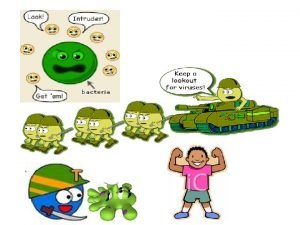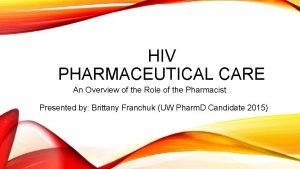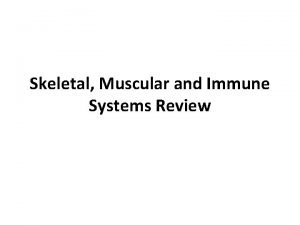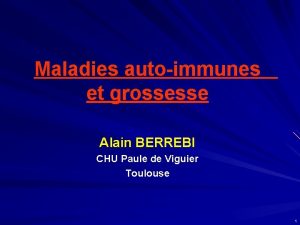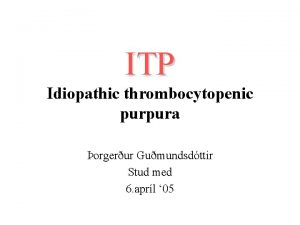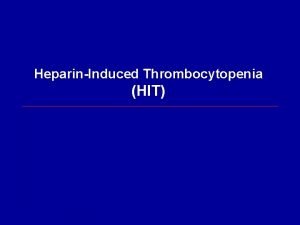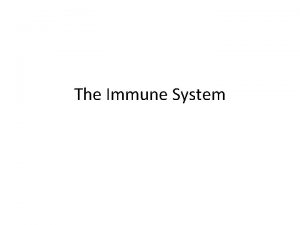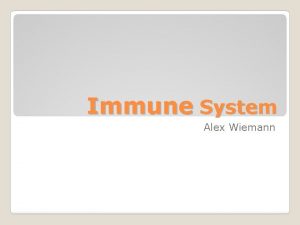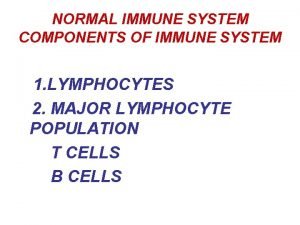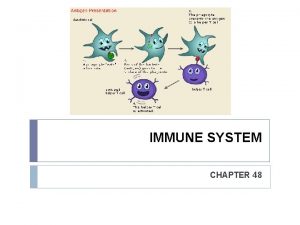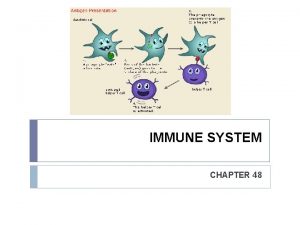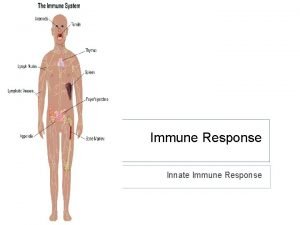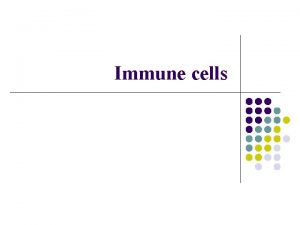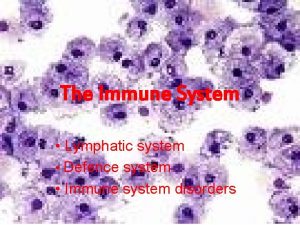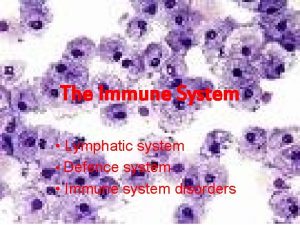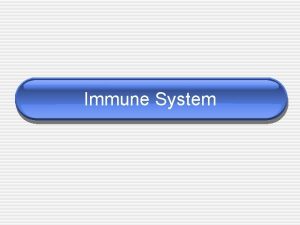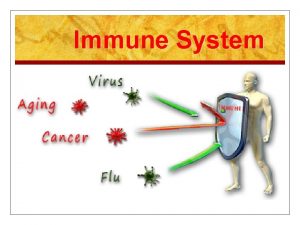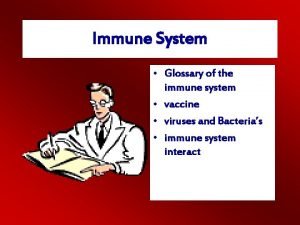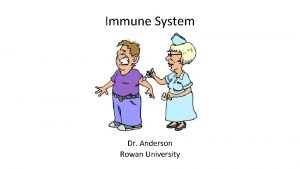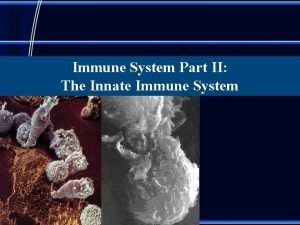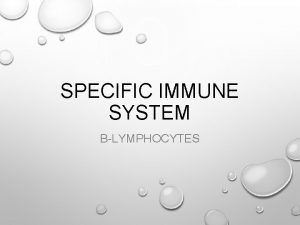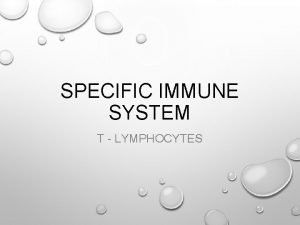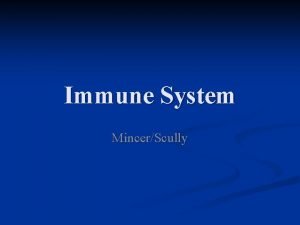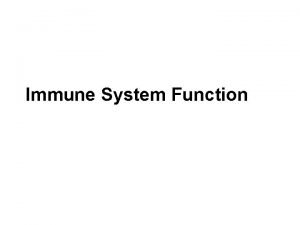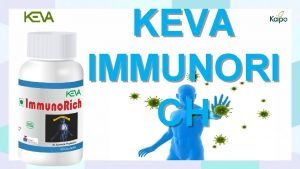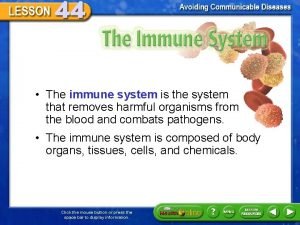IMMUNE SYSTEM The Immune System Recall the components



















































- Slides: 51

IMMUNE SYSTEM

The Immune System Recall the components of blood Recall what is a pathogen Recall the function of the skin

Two types of immune response Non-specific External E. g. Skin, mucus, tears Internal Phagocytic cells, antimicrobial proteins, inflammatory response Specific E. g. lymphocytes, antibodies

Innate immunity Plants and animals have mechanisms that target a wide range of pathogens


Skin and the mucus membrane as the first line of defense Imagine a body without a skin First, it is gross Secondly, it is not protected against invading pathogens Epithelial lining makes a good barrier against pathogens Mucus membrane lines the digestive, respiratory and genitourinary tracts

The skin Not only function as a barrier Secretions from sebaceous(oil) and sweat glands make it acidic p. H range of 3 -5 Most bacteria cannot live in an acidic environment Normal flora are adapted to this kind of environment

Mucus and other substances Mucus, saliva, tears- washes pathogens that might enter the body Antimicrobial proteins are also present Lysozyme- destroys cell wall of bacteria Destroys bacteria that might enter through the respiratory tract or around the eyes

Mucus and other substances Mucus- traps some microbes Is moved by the beating cilia in the respiratory tract Bacteria in mucus that is swallowed is destroyed in the stomach Hepatitis A can live in acidic environment

Cilia

Phagocytic cells, inflammation, antimicrobial proteins When an opening occurs in the skin through abrasion or wound the second line of defense is activated Phagocytosis is the main mechanism employed by the body Phagocytosis- synergistic with inflammation and antimicrobial protein response

Phagocytic cells and natural killer cells Mostly made up of neutrophils (60 -70%) Damaged cells release chemical signals that attract neutrophils Engulfs damaged cell (neutrophils are also destroyed) Monocytes 5% of WBC Become macrophages Long-lived cells Engulfs cell to form vacuoles that fuse with lysozymes (lysosomes)

Macrophage engulfing two RBC Two actions of macrophage: 1. Through toxic forms of O 2 -superoxide anion -nitric oxide 1. Use of lysozyme

Resistant bacteria towards lysosomal destruction Mycobacterium tuberculosis Resistant to lysosomal destruction Can even proliferate inside the macrophage

Specific Macrophages Lung- alveolar macrophage Liver- Kupffer’s cells Kidney- mesengial cells Brain-microglial cells Connective tissue-histiocytes

Still on the types of leukocytes. . . Eosinophil- make up 1. 5 % of all WBC Action is on parasites (e. g. vermiform such as Schistosoma mansoni) discharge destructive enzyme from their cytoplasmic granules on the external wall of parasites Other non-specific defense Natural killers cells (NK cells)- do not attact pathogens directly Destroy infected cell as well as abnormal body cells do not engulf cells, rather lyse infected cells

Schistosoma mansoni


The lymphatic system

The inflammatory response Injured area: precapillary arteriole dilates; postcapillary venule constrict- WHY?

The inflammatory response To increase blood supply- so what? This in turn will lead to edema

The inflammatory response Inflammatory response may be caused by the following: From the pathogen itself Histamines released by the body (from basophils and mast cells) Prostaglandins (dilate/constrict BV or aggregate/disaggregate clotting factors)

Phagocytosis during inflammatory response Phagocytosis begins an hour after an injury occurred Phagocytic cells move in the area through the increased permeability of the BV Attracted to chemotactic factors released by the pathogens Chemokines released by endothelial cells, monocytes can also attract phagocytic cells

Chemokines Bind to receptors of different leukocytes E. g. Induce toxic form of oxygen in lysosome Release of histamine from basophil

Sequence of events. . After inflammation, phagocytic cells arrive on the scene Neutrophils arrive first, followed by macrophages Macrophage- engulfs pathogens and other debris Pus- made up of dead phagocytic cells, fluid and proteins that leaked from the BV

Severe infection Fever is an immune response to severe infection Can be caused by the pathogens May be due to pyrogens released by some leukocytes Can facilitate phagocytosis Septic shock- high fever, hypotension

Antimicrobial proteins Proteins that attack microbes or stall reproduction of microbes Lysozyme is an example Also, presence of the complement system Made up of 20 serum proteins Action: lysis or attraction of phagocytic cells Is also part of specific immune response

Antimicrobial proteins Interferons Secreted by virus-infected cells Neighboring cells are stimulated to produce chemicals that can inhibit viral infection Not virus-specific A specific type of interferon activates phagocytes

Self vs Non-self Self recognition is important in an immune response Presence of receptors/markers in pathogens that enter the body Very efficient, even undigested proteins are considered as antigens

Self vs Non-self Lymphocytes react on special surface glycoproteins encoded by genes called Major Histocompatibilty Complex (MHC) In Humans, Human Leukocyte Antigens (HLA) Class I MHC- Almost all nucleated cells Class II MHC- macrophages, B cells, activated T cells, cell in the interior of the thymus Varies from one person to another

Invertebrate immunity Self and non-self is also exhibited by invertebrates starting from sponges Cells of different sponge species if mixed sort themselves and reaggregate Coelomocytes- phagocytic cells in sea stars Cytokines are also present E. g. Coelomocytes produce interleukin-1 that enables proliferation of coelomocytes

coelomocytes Coelomocytes from Placobdella Sea urchin coelomocyte

More on invertebrate immunity Makes use of innate, non-specific rather than active Exception is the hemolin protein in the hemolymph of insects Hemolin acts like vertebrate lymphocyte Hemolin belongs to the immunoglobulin superfamily

Absence of immunological memory Memory cells of vertebrates increase the immunological response of the body towards a pathogen Coelomocytes do not possess this trait Another exception: the earthworms First graft is rejected for two weeks Second graft is rejected in about a week

Active immunity vs Passive immunity Active immunity- immunity through recovery from a disease Natural or artificial Passive immunity- immunity passed by another individual short-lived

Specific immunity: the third line of defense Lymphocytes- cells responsible for the specific immune response There are two types: B cells and T cells Antigen- molecules that elicit specific response from lymphocyte E. g. Molecules from bacteria, fungi, virus, parasitic worms Antigens activate B cell in producing antibodies


Recognition of antigens by B cells and T cells Specificity is possible because membrane-bound antigen receptor B cell antigen receptor- transmembrane version of antibodies Also called membrane antibodies T cell antigen receptor- called T cell receptor Structurally related to membrane antibodies T cell receptor never released in secreted form

Clonal selection Antigen binds to a specific antigen receptor (B cell) B cell produce its clone Some B cells become plasma cells (short-lived) that can secrete antibodies to the specific antigen Plasma cells- also called effector cells Some B cells become memory cells (long-lived) for re -exposure to the antigen

Immunological memory Primary immune response- selective proliferation and differentiation of lymphocytes upon first exposure 10 -17 days to develop maximum effector cells Selected B cells and T cells produce their respective effector cells

Immunological memory Secondary immune response- re-exposure to the same antigen response is faster, greater magnitude, more prolonged Also, more antibodies are produced Antibodies have greater affinity to the antigens Secondary response is called immunological memory

Graph showing immunological memory

Lymphocyte development All blood cells develop from pluripotent cells Lymphocytes also develop from pluripotent cells T cells- mature in the thymus B cells- mature in the bone marrow

Immune tolerance for self Maturing lymphocytes’ antigen receptors are rendered non-functional If antigen receptors cannot be switched off, lymphocytes undergo apoptosis

The other cells. . Cytotoxic T cells- kills cells through lysis Helper T cells- bind to antigen cell and secretes cytokine Antigen-presenting cells (APCs)- engulfs bacteria (virus) and presents fragment of these pathogens to other lymphocytes

Humoral response and cell-mediated response Humoral immunity- involves B cell activation, production of antibodies in blood plasma and lymph called humor Cell-mediated immunity- action of T cells

Overview of humoral response Macrophage engulfs the pathogen Class II MHC binds to fragment of pathogen MHC-antigen complex is presented by the phagocytic cell A helper T cell with specific receptor for the antigen makes contact with the macrophage and releases cytokines

Overview of humoral response Activated T cell presents the antigen to a B cell Cytokines activates the B cell Activated B cells differentiate into plasma and memory cells Plasma cells will produce the specific antibodies

Cell-mediated immune response Occurs when antigen displayed by APC activates Cytotoxic T cell Cytotoxic cell can differentiate to Memory T cells or active cytotoxic T cells Active against cancer cells and pathogens Kills these cell through lysis

Antibodies Do not destroy antigens directly Rather, neutralizes it or present it as a target for opsonization, agglutination, precipitation, or complement fixation, neutralization

Antibodies Opsonization- coating of antigens by antibodies to facilitate phagocytos Neutralization- binds to the antigen and inactivates it Agglutination- clumping of bacteria or virus to effectively neutralize or opsonize it Complement fixation or precipitation- immune adherence occurs Microbes coated with antibodies and complement proteins adhere to BV walls
 Primary immune response and secondary immune response
Primary immune response and secondary immune response What is the third line of defense in the immune system
What is the third line of defense in the immune system Flow chart
Flow chart Third line of defense immune system
Third line of defense immune system Second line of defense immune system
Second line of defense immune system Chapter 35 immune system and disease
Chapter 35 immune system and disease Primary vs secondary immune response
Primary vs secondary immune response Ap biology immune system
Ap biology immune system Lesson 12 blood and immune system
Lesson 12 blood and immune system Lesson 12 blood and immune system
Lesson 12 blood and immune system Immune system lymph nodes
Immune system lymph nodes Immune system def
Immune system def Overreactions of the immune system
Overreactions of the immune system Lymphatic vs immune system
Lymphatic vs immune system Lymphatic vs immune system
Lymphatic vs immune system Defination of tuberculosis
Defination of tuberculosis What is the first line of defense
What is the first line of defense Main function of the immune system
Main function of the immune system Peyer's patches
Peyer's patches Thymus immune system
Thymus immune system Immune complex
Immune complex Immune system structure
Immune system structure 1what's the purpose of the body's immune system?
1what's the purpose of the body's immune system? Rapid recall system
Rapid recall system Spalding sign
Spalding sign Difference between innate and learned behavior
Difference between innate and learned behavior Chapter 55 care of the patient with an immune disorder
Chapter 55 care of the patient with an immune disorder Chapter 24 the immune and lymphatic systems and cancer
Chapter 24 the immune and lymphatic systems and cancer Immune checkpoint inhibitors mechanism of action
Immune checkpoint inhibitors mechanism of action Immune reconstitution inflammatory syndrome
Immune reconstitution inflammatory syndrome Predeksihkhariini
Predeksihkhariini Immune complex glomerulonephritis
Immune complex glomerulonephritis Mbg 453
Mbg 453 Primary immune response
Primary immune response Immune effector cells
Immune effector cells Unsaturated alcohol crossword clue
Unsaturated alcohol crossword clue Dr patrick kormann
Dr patrick kormann Immune defintion
Immune defintion Lupus
Lupus Primary and secondary immune response
Primary and secondary immune response Cellular immune response
Cellular immune response Adcc immune
Adcc immune Cellular immune response
Cellular immune response What empties into the left subclavian vein
What empties into the left subclavian vein Immunity classification
Immunity classification Immune reconstitution therapy
Immune reconstitution therapy Type of muscle
Type of muscle Maladie auto immune connectivite
Maladie auto immune connectivite Immune thrombocytopenic purpura
Immune thrombocytopenic purpura Immune complex
Immune complex Immune thrombocytopenia
Immune thrombocytopenia Virosome
Virosome







